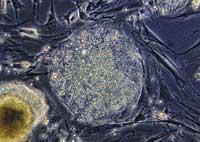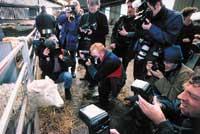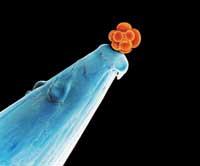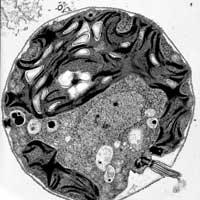Eve and human cloning
2003/02/01 Carton Virto, Eider - Elhuyar Zientzia Iturria: Elhuyar aldizkaria
But when I write this article fifteen days have passed and we remain the same. Eva has not been seen by anyone and no evidence has come anywhere, yes, we have perfectly known who the Raeleses are.
The Rael were born 30 years ago in France. In 1973, a French journalist known as Raël, appears an alien being and reveals the truth: man was born in laboratories, by cloning, 25,000 years ago. In gratitude for the honor, Raël wanted to live up to those wise aliens and cloned the man again. And following the alien method, he has shown us before the world and transmitted his truth to us.

But here, on Earth, at least among scientists, we work differently. Studies are published in journals for others to read and discuss. Prove its truthfulness. Providing data and showing results. In addition, it can be repeated if desired. If these requirements are not met, research results are not accepted.
The Rael have given no proof, but many suspect they have achieved what they wanted: advertising and money. It is only possible to access the website of the company Clonaid, created by them, to achieve the economic objectives. Paying 200 euros a year, they will save my frozen genome to cure the diseases I may have in the future or create an organ that needs it. And for 5,000 euros I can buy an egg. They don't specify how much you would have to pay for cloning, but they can do it smoothly. They say cloned beings are very healthy.
The truth of scientists
Dolly was born in 1996 after 277 failures and, although at first seemed healthy, last year had detected arthritis. On the way to the first clonic mouse 274 were also lost. And the same with other animals.

Scientists have insisted that cloning techniques are only in their beginnings, have very little success, are lost more than a hundred times for every clone that lives and those who live also have health problems.
Sheep, mice, pigs and cows have been cloned, but the process is not well understood and much remains to be learned. For example, a monkey has not yet been cloned. Therefore, the attempt to clone human beings would be a barbarity. But not because cloning is negligible in itself, but because the technique does not meet for the moment the minimum viability requirements that studies with humans must meet. This nuance is very important since human cloning generates intense ethical debates in recent times.
The prediction of the Rael has given a new breath to these debates and to which many arguments consider cloning reprehensible. These groups, usually based on religious values, also condemn therapeutic cloning, that is, the creation of human embryos by cloning, from which stem cells are extracted and research is carried out.
Stem cells have the ability to become any cell in the body and researchers believe that working with them can one day treat a lot of diseases, including many that today have no remedy: Alzheimer, Parkinson, diabetes, sclerosis, etc. These powerful cells are present in all tissues, but many scientists believe that the most embryonic are more powerful. In addition, the stem cells of an embryo produced from a cell of its own would be the most suitable for therapeutic use. In fact, there would not be so much risk of rejection. Cloning is an essential step to achieve this and is what is called therapeutic cloning. It is clear, therefore, that the goal has nothing to do with the creation of another living being.

Reproductive and therapeutic cloning have the same technical basis, but they are not the same. The creation of clones for therapy involves the creation of cells that is scientifically viable. The other refers to the placement of these cells in a woman's uterus and the development of the entire pregnancy, and in view of the results obtained in animals, today is not viable.
That's why Clonaid's announcement is so harmful. Despite the little credibility of the group, cloning is a topic that is barely known on the street, and in these cases everything is mixed and spread easily. That's what those who want to ban all the research done around cloning do. Refuse everything without distinguishing objectives and means. It would not be so serious if society had direct information and these groups less power, but unfortunately on the street there is more talk of cloned children than of the real situation of investigations.
European governments are now discussing whether or not to legalize human embryo research. If fear and religious prejudice win, one of the great challenges of biomedicine risks being abandoned. Or clandestine.
In the end we would all perceive the loss, even those anchored in negative.

Gai honi buruzko eduki gehiago
Elhuyarrek garatutako teknologia






